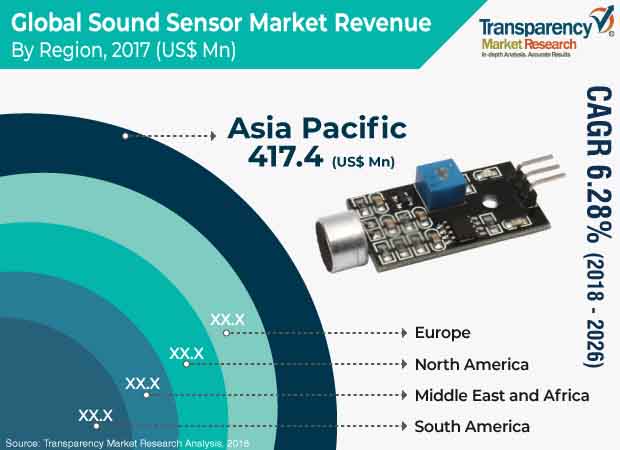Sound Sensor Market – Global Industry Demand, Share, Top Players, Industry Size, Future Growth
The global sound sensor market was valued at US$ 1,270.3 Mn in 2017 and is projected to register a compounded annual growth rate (CAGR) of over 6% from 2018 to 2026, according to a new report published by Transparency Market Research (TMR) titled ‘Sound Sensor Market – Global Industry Analysis, Size, Share, Growth, Trends, and Forecast, 2018–2026.’ The report suggests that rising significance of security and surveillance systems across the globe, increasing demand for voice recognition systems, and growing use of sound sensors in several medical applications are likely to augment the demand for sound sensors from 2018 to 2026. Since key players are introducing innovative sound sensors in developed markets such as North America, Europe, and Asia Pacific, these regions are likely to account for a leading share of the global sound sensor market during the forecast period. Rising investments in smartphone and automotive technologies and industrial automation across emerging markets such as China, Japan, South Korea, and India are likely to boost the sound sensor market in Asia Pacific from 2018 to 2026.
Want to know the obstructions to your company’s growth in future? Request a brochure

Working limitations of sound sensor to hamper the sound sensor market
Sound sensors including ultrasound, acoustic, and audio sensors come with several advantages such as high sensitivity and ability to function across numerous industrial as well as medical applications. However, sound sensors have certain limitations as well. Ultrasound sensors cannot be used in vacuum, as sound waves require air as a medium for transmission. Moreover, these sensors may not function in any type of liquid medium. Thus, sound sensors need to be selected by considering all these limitations. Additionally, sensing ability of certain sound sensors is affected by soft edges of any surface as well as a certain level of temperature. These limitations of sound sensors are likely to hinder the global sound sensor market, with a medium-level impact, in the near future.
Sound sensor is significantly adopted by the consumer electronics sector
In terms of application, the global sound sensor market has been segmented into health care, automotive, consumer electronics, security & surveillance, industrial, and others. The others segment comprises aerospace and chemical. In the consumer electronics industry vertical, sound sensors are used largely in smartphone devices for object detection, as a microphone, and as a fingerprint scanner. Technologically advanced, new-generation sound sensors i.e. ultrasonic sensors are replacing optical-proximity sensors, thereby improving the smartphone design. Several manufacturers are coming up with innovative ultrasonic sound sensors to be incorporated in a large number of smartphones. For instance, Qualcomm Incorporated, a semiconductor company, announced the launch of an innovative in-display fingerprint sensor in 2018. This sensor is based on the new 3D and ultrasonic sensor technology that uses sound waves to collect fingerprint data. Furthermore, the device is capable to read fingerprints contaminated by water or oil.
Asia Pacific to continue to hold a major share of the global sound sensor market
Asia Pacific is expected to hold a major share of the global market for sound sensors during the forecast period. Leading share of the region is primarily attributable to strong presence of well-established players across the region, especially in prominent economies such as China, Japan, and South Korea. Governments of China and Japan are investing heavily in smartphone and semiconductor technologies. Furthermore, the automotive industry in Asia Pacific is expanding prominently, owing to the increasing demand from Japan and China. Asia Pacific is home to several well-established players that manufacture sound sensors including Badger Meter, Inc., OMRON Corporation, Murata Manufacturing Co., Ltd., Benthowave Instrument Inc., and numerous emerging and smaller players.
Looking for exclusive market insights from business experts? Request a Custom Report
Moreover, Asia Pacific is witnessing high adoption of sound sensors, due to continuously increasing industrial automation and growing automotive industry in the region, which uses sound sensors significantly. Several manufacturers in the region are focusing on enhancing the quality of their products, showcasing their products by participating in several trade shows, and focusing on customer satisfaction. For instance, OMRON Corporation offers high-quality and technologically advanced industrial automation solutions including ultrasonic sensors. The company also provides customer support for its products. Additionally, the company conducts customer satisfaction surveys in various countries, on a regular basis, to identify and analyze customer requirements.
Key players such as Siemens AG, STMicroelectronics, Murata Manufacturing Co., Ltd., Robert Bosch GmbH, and TE Connectivity Ltd. to lead the global sound sensor market
The report includes profiles of well-established players operating in the global sound sensor market. These include Siemens AG, STMicroelectronics, Murata Manufacturing Co., Ltd., Robert Bosch GmbH, and TE Connectivity Ltd. These players are focusing on providing high flexibility to their customers in terms of buying products. In 2018, TE Connectivity Ltd. launched its innovative online store called ‘TE Store,’ which provides customers with an option to buy TE products such as connectivity solutions and sensors directly. The online store offers a high level of flexibility to customers, as they can easily compare and buy products of various companies from TE Store.
You May Also Like PRNewswire on Mine Planning Solutions Market

